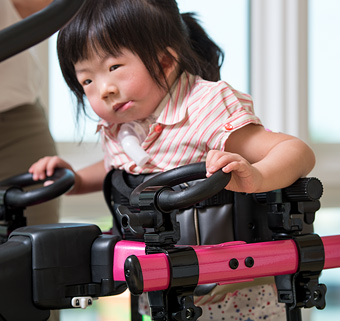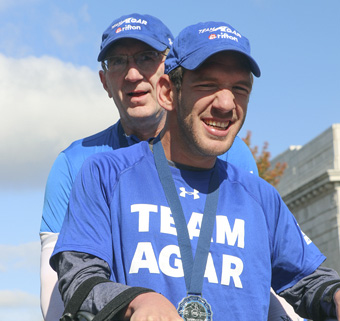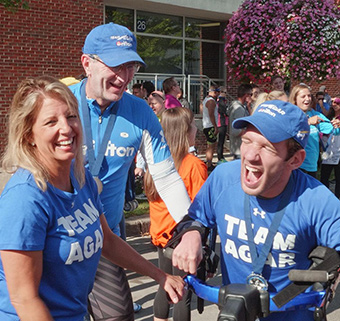Arm Prompts
Pacer Positioning in Depth
Cathy Ripmaster, MSPT demonstrates the arm prompts on the Rifton Pacer and discusses positioning for effective gait training.
Introducing the Arm Prompts
[00:04] Hello, it’s Cathy Ripmaster, physical therapist, and today I’m going to talk to you about the Rifton Pacer and the arm prompts. Right now I have everything stripped down so I can just show you the arm prompts without any kind of distractions, and so you can see it clearly. But the arm prompts are really important. A lot of times the kids that I work with, they don’t like the arm prompts, but it should really be the last thing that you take off of the frame. Because you can remove all the prompts from the Pacer, and you could actually turn it around so that it is a posterior walker; so getting them used to holding onto things is really important to progress them to using just the frame. So today I’m going to show you all the different adjustments on just the standard arm prompt. There’s also the hand holds and there are also the arm platforms; but today we’re just going to talk about the basic one, the arm prompt.
Location of the Prompt on the Frame
[01:00] So the first thing I want to talk to you about is the location on your frame. Right now my frame is kind of a little bit low; I’m going to raise it up a hair. I’d like that at my hip level. And right now my arm prompts are out here. This is a position that I sometimes see students that I work with positioned in, so that when they have their chest prompt, they’re kind of hanging forward with their arms out to the side. The best position for your individual that you’re working with is actually to have their arms closer to midline, so that they have a nice ninety degree angle here. Their shoulders are not elevated; but their shoulders are down, elbows bent. That way they can use their arms to push up at their trunk if they’re a little bit weaker. If their arms are out here and they’re trying to push, they’re less likely to push; they’re more likely going to just sink further and further into a flux position. So there are quite a few different options on the Pacer.
Adjusting the Bracket
[02:02] The first adjustment is the bracket. So I’m going to go ahead and take off the arm prompt and show you the bracket. Right now my bracket is on the outside of the frame versus the inside here. So the way that I had it positioned before, it was pretty far out. And again this is so adjustable for the different sizes, how your student is presenting with high or low tone, if they have any reflexes. So all of this is going to change based on how your student, how your individual you’re working with is presenting. And some days, unfortunately, they present differently. So you might have to do some small adjustments here and there once you get it set up to them. So it’s really important that you know what those adjustments are, and that you’re teaching those who are working with the individuals how to make those minor adjustments – because that can make a big difference between them walking and not walking.
[02:58] So the bracket can go on the inside on the frame, and you can see that there is some adjustment, to slide that bracket forward or backwards. And then you’re going to hit this crossbar. You could also put your bracket on the other side of the crossbar, depending on how many prompts you need. And again that can be slid. If you want the arm prompts here, so they can use it as a posterior walker – maybe have their legs free so they can kick things – you could actually put your arm prompts way on the other side, so that you’re kind of progressing them a little bit further to using this as a posterior walker. So there’s not as much adjustment on the frame, if you’re using a chest prompt, to have the arm prompts on this side. So I’m going to focus mainly on having the bracket in front of this crossbar on the Pacer. So right now my bracket is on the inside, and I’m going to leave this bracket on the outside, so I can kind of show you the difference between the two. So I showed you the bracket.
Adjusting the Height
[04:09] Now the height of it is adjustable by pushing this white button. You can make it all the way down, you can raise it all the way up. A lot of times, I count the notches in here; and you can have four notches showing or you can have none, and anywhere in between, as you are adjusting it. You can also adjust your L bar, I just call this my L bar. You can have it so it is facing forward, you can have it so it’s facing in, you can have it so it’s facing towards you, and you can have it facing out. All of these different adjustments will allow your armrest to be in a different position. So I’m going to go ahead and bring mine in right now, just so you can see a nice midline position supported. So depending on the height of your frame, you could adjust this up and down. Again, your frame height should be at your hip level. The reason why you need it at your hip level is because as they’re turning, it will allow the Pacer to move with them a lot easier, so they have a lot more freedom of movement.
Adjusting the Angle
[05:18] So once you have your L bar configured how you want it, you also have this adjustment underneath. So you just loosen up this knob, and this little bracket moves all the way around. That’s hard for you to see. But you can have, depending on your bracket, you can have the hole facing this way. And that will allow you to adjust the arm prompt up and down. So I’m going to slide that in. And you can see – I can adjust that so it’s down, or I can adjust it so it’s angled up, or just at midline. And then once it’s on there, you can rotate this bracket so even if their arm needs to be here…ideally you would want it here. So you can adjust the bracket; and then make sure you tighten it up.
Forward and Backward
[06:10] And then you also have a way to slide. If this knob underneath is loose, you can slide it forward or backwards. So you have a height adjustment; you have an angle adjustment based on your L bar. You have an adjustment so you’re angling up or down. If your bracket is facing forward this way, or towards me this way, you can actually also angle your arm prompt so it’s this way or this way. But again, we’re just going to make it at midline right now. So once you have that adjustment, everything is tightened. I’m going to go ahead and adjust my left one right now. And I’m going to loosen up the knob, slide it out, rotate. It is nice to have the arm prompt ideally nice and snug against the body. So when the arm prompt is right here like my left one – this one’s out a little bit further – but when it’s here, it will allow the student or the individual you’re working with to use their arms to push themselves up. And it makes them have some stability and weight bearing through their arms and their shoulders, as opposed to just being supported on the seat or the chest prompt. So this will really allow them to push their trunk up.
Your Client
[07:44] But I have to tell you, I have a lot of students who do not like having their arms strapped in place and in midline. So many of the students that I work with are so busy getting their arm out of however I have it positioned, they’re no longer focused on walking. So sometimes I have their arms in an asymmetrical position, so I might need to have one arm out. If I have a student that I’m working with that has a really strong ATNR – sometimes if I get some elbow flexion on the arm they like to have straight and they’re looking towards – sometimes if I break up that flex or that extension and put them into flexion, that would be enough to break up the ATNR. Sometimes I do that and they’re good. Sometimes I do that, and then they’re constantly getting that arm out. That’s okay. If they’re constantly trying to get that arm out, they’re not going to be walking. So what I might do is have the arm that they want to keep in flexion flexed. And the arm they want to kind of pull out and go into an ATNR, I’m going to allow that arm to be extended. That might mean that that arm needs to be extended out to the side. And sometimes you can get that arm extended out in front. And I found that this position is kind of a compromise to having arms supported here. And a lot of my students will tolerate having that arm straight in front of them as opposed to needing it out to the side.
[09:12] But I still have the occasion of a student that tries to get it out to the side. So in order to make that adjustment for this arm prompt to be angled down, my L bar cannot be facing forward or towards me – it needs to be facing at an angle. So I’m going to adjust that by taking it out, sliding it back in. And then I’m going to change the angle of my arm prompt by changing the slots that it’s going to be in on this round part here. So right now I have some nice elbow extension. I might be able to adjust the handle so they can get some nice hand and wrist support. I can adjust it so that it’s down, and I have one flexed. So this is one way that you can adjust your Pacer for your individual needs of the person you’re working with. Sometimes I have a student that has a really strong extensor pattern, and they want both arms extended. So you would do the same thing that you did with this right one, and make both of them extended. And sometimes if they have good hand support, they’re actually pushing themselves up. Sometimes, though, they might need some support behind their head, if they have their arms here and it’s allowing them to push back into extension. And we can talk about that in another video that I’m doing.
Placing the Arm Prompt Below the Frame
[10:34] So this is just the real basic of some positions that you could do. Another one that I sometimes do is…sometimes I put the arm prompt underneath the frame. So I would take out my L bracket, and I would slide it up through the bottom this time. And depending on my student and how they’re presenting – it’s a little bit tricky – depending on how far down you need to have it. And because of this front part of the Pacer, your angle sometimes is different. But sometimes I might need to have the arm prompt all the way underneath the frame. So I’m going to back up so you can see that. So it’s underneath the frame, so that maybe they can be supporting their hand here. Ideally I think it would be better here, so it would just be a matter of changing your L bar and bringing it in and allowing the armrest to be here. Sometimes this is the position the student is most comfortable in. I’ve also put it on the other side of the bracket so it’s down here. A lot of times when I have students who are locking out their elbows, they’re doing that for stability. So another way that I can provide stability if they need to be locked out for that stability, is to be providing maybe a lateral arm support.
Creating an Arm Block with the Arm Prompt
[12:00] So instead of having the armrest down low, I could also adjust it so that that armrest…I have my L bar facing forward. That angle might just need to be different for me. And I have just an arm block. You can play around with this angle so that they’re getting the most contact. Maybe it needs to be down lower like this, so they’re not pulling their elbow back. Sometimes I find that if I have a student who likes to pull this elbow back, they’re also rotating in their trunk; and they’re rotating so much that it’s distracting them from being able to stop. So having an arm block on here – which might be better if the bracket is on the outside of the frame versus on the inside, you just kind of have to play around with that – so if the support is here, you’re blocking them from doing some rotation. That might help them have some more forward progression of the Pacer as well.
Placing the Arm Prompt High Up
[13:12] Another position that I sometimes use is for a student that has a kyphosis. So that is when their shoulders are forward; a lot of times their back is rounded. Sometimes I find that if their arms are up here, it allows them to open their chest up, and they can see. So in order to achieve that position, I would maybe angle my arm prompt. My L bar is going to need to be facing either in or out depending on my student.
[13:50] Right now, actually I don’t know if I showed you, there’s this bracket right here. I’m going to flip it so that there’s more space above instead of below. Right now there’s a lot more space below. That will allow my arm prompt to go up a little bit higher. So you can see, this time my arm prompt is way up high. Not necessarily anything below my elbow to block it, but sometimes you can adjust a strap there so the strap is supporting them. But it will give them – it will give the individual you’re working with – a place to push when they want to be in this kyphotic position. Having their arms supported can help push them up so that they are able to open their chest up a little bit more, be able to more see where they’re going, and allow them to be in their position of their trunk. So when you have an individual with that kyphosis, sometimes it is helpful to have their arms supported up like this. And then what you would do is to bring, you might need to bring their chest prompt back on here. And then you might need to open up the back straps of the chest prompt so it will allow their back to open up. But then you might also need to bring their pelvis forward. And that is sometimes a really good position for my students who have a kyphosis, to be able to raise their head up and to be able to open up their chest, and allow them to walk while they’re in the Pacer.
Conclusion
[15:23] I think I pretty much covered everything today with the arm prompts. I hope you have found this video helpful, and I hope that you can just explore a lot of the positions on the Pacer. The best way to explore it is to get in it yourself. Figure out the best position that the individual you’re working with, they could function. So it’s a matter of getting comfortable with changing all these prompts. It’s a matter of playing around with it. If they always want to do this, how can we bring them in? What position is going to make them most comfortable, so they’re not fighting these arm prompts. If you don’t have to use the straps, the better. If they’re comfortable, maybe you wouldn’t have to strap their arm down to keep it there. Maybe they’re constantly pulling it out because they don’t like the position of their shoulder. So play around with the Pacer with you in it to kind of see how it would be most comfortable for the patient or the individual that you’re working with. Thank you so much, and I hope you enjoyed this video. Take care.




